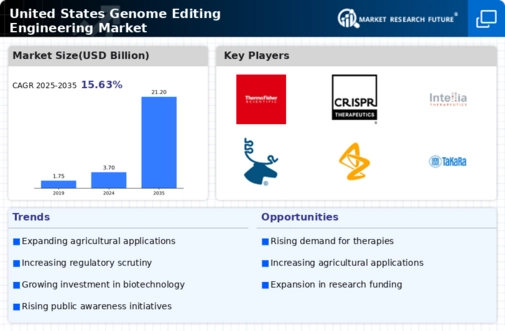Chart: Market Growth Projections
The Global United States Genome Editing Engineering Market Industry is projected to experience substantial growth over the next decade. The market is expected to reach 15.75 USD Billion in 2024 and is anticipated to grow to 45.23 USD Billion by 2035. This growth trajectory indicates a compound annual growth rate of 10.07% from 2025 to 2035, reflecting the increasing adoption of genome editing technologies across various sectors, including agriculture, healthcare, and biotechnology.
Advancements in CRISPR Technology
The Global United States Genome Editing Engineering Market Industry is experiencing rapid advancements in CRISPR technology, which is revolutionizing genetic engineering. CRISPR-Cas9, a prominent tool, allows for precise modifications in DNA, enabling researchers to target specific genes with unprecedented accuracy. This innovation has led to breakthroughs in agriculture, medicine, and biotechnology, fostering a surge in research and development activities. As a result, the market is projected to reach 15.75 USD Billion in 2024, reflecting the growing adoption of CRISPR technology across various sectors. The potential applications in gene therapy and crop improvement further underscore the importance of these advancements.
Regulatory Support and Frameworks
The Global United States Genome Editing Engineering Market Industry benefits from evolving regulatory support and frameworks that facilitate the safe application of genome editing technologies. Regulatory bodies are increasingly recognizing the potential benefits of gene editing in agriculture and medicine, leading to the establishment of guidelines that promote innovation while ensuring safety. This supportive environment encourages investment and research, as companies can navigate the regulatory landscape with greater clarity. As the market continues to mature, the establishment of robust regulatory frameworks is likely to enhance public trust and acceptance, further driving market growth and innovation in the coming years.
Rising Demand for Precision Medicine
The demand for precision medicine is a significant driver of the Global United States Genome Editing Engineering Market Industry. As healthcare shifts towards personalized treatment approaches, genome editing technologies play a pivotal role in developing targeted therapies. These innovations allow for the customization of treatments based on individual genetic profiles, improving patient outcomes and reducing adverse effects. The market is poised for substantial growth, with a projected compound annual growth rate of 10.07% from 2025 to 2035. This trend reflects a broader shift in healthcare towards more effective and tailored solutions, positioning genome editing as a cornerstone of future medical advancements.
Increasing Investment in Biotechnology
Investment in biotechnology is a critical driver for the Global United States Genome Editing Engineering Market Industry. With a growing recognition of the potential of genome editing, venture capital and government funding are increasingly directed towards biotech firms specializing in genetic engineering. This influx of capital supports research initiatives and accelerates the development of innovative solutions. The market is expected to expand significantly, with projections indicating a growth to 45.23 USD Billion by 2035. Such financial backing not only enhances the capabilities of existing companies but also encourages new entrants, fostering a competitive landscape that drives further advancements in genome editing technologies.














Leave a Comment